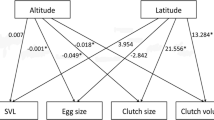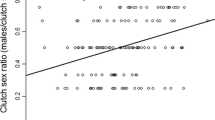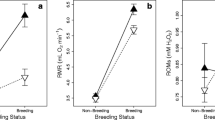Abstract
Maternal investment in reproduction by oviparous non-avian reptiles is usually limited to pre-ovipositional allocations to the number and size of eggs and clutches, thus making these species good subjects for testing hypotheses of reproductive optimality models. Because leatherback turtles (Dermochelys coriacea) stand out among oviparous amniotes by having the highest clutch frequency and producing the largest mass of eggs per reproductive season, we quantified maternal investment of 146 female leatherbacks over four nesting seasons (2001–2004) and found high inter- and intra-female variation in several reproductive characteristics. Estimated clutch frequency [coefficient of variation (CV) = 31%] and clutch size (CV = 26%) varied more among females than did egg mass (CV = 9%) and hatchling mass (CV = 7%). Moreover, clutch size had an approximately threefold higher effect on clutch mass than did egg mass. These results generally support predictions of reproductive optimality models in which species that lay several, large clutches per reproductive season should exhibit low variation in egg size and instead maximize egg number (clutch frequency and/or size). The number of hatchlings emerging per nest was positively correlated with clutch size, but fraction of eggs in a clutch yielding hatchlings (emergence success) was not correlated with clutch size and varied highly among females. In addition, seasonal fecundity and seasonal hatchling production increased with the frequency and the size of clutches (in order of effect size). Our results demonstrate that female leatherbacks exhibit high phenotypic variation in reproductive traits, possibly in response to environmental variability and/or resulting from genotypic variability within the population. Furthermore, high seasonal and lifetime fecundity of leatherbacks probably reflect compensation for high and unpredictable mortality during early life history stages in this species.






Similar content being viewed by others
References
Bell BA, Spotila JR, Paladino FV, Reina RD (2003) Low reproductive success of leatherback turtles, Dermochelys coriacea, is due to high embryonic mortality. Biol Conserv 115:131–138
Bennett AF (2003) Experimental evolution and the Krogh principle: generating biological novelty for functional and genetic analyses. Physiol Biochem Zool 76:1–11
Bjorndal KA, Carr A (1989) Variation in clutch size and egg size in the green turtle nesting population at Tortuguero, Costa Rica. Herpetologica 45:181–189
Bowden RM, Harms HK, Paitz RT, Janzen FJ (2004) Does optimal egg size vary with demographic stage because of a physiological constraint? Funct Ecol 18:522–529
Caut S, Guirlet E, Jouquet P, Girondot M (2006) Influence of nest location and yolkless eggs on the hatching success of leatherback turtle clutches in French Guiana. Can J Zool 84:908–915
Congdon JD (1989) Proximate and evolutionary constraints on energy relations of reptiles. Physiol Zool 62:356–373
Congdon JD, Gibbons JW (1985) Egg components and reproductive characteristics of turtles: relationships to body size. Herpetologica 41:194–205
Congdon JD, Gibbons JW (1987) Morphological constraint on egg size: a challenge to optimal egg size theory? Proc Natl Acad Sci 84:4145–4157
Congdon JD, Nagle RD, Dunham AE, Beck CW, Kinney OM, Yeomans SR (1993) The relationship of body size to survivorship of hatchling snapping turtles (Chelydra serpentina): an evaluation of the “bigger is better” hypothesis. Oecologia 121:224–235
Dunham AE, Grant BW, Overall KL (1989) Interfaces between biophysical and physiological ecology and the population ecology of terrestrial vertebrate ectotherms. Physiol Zool 62:335–355
Finkler MS, Claussen DL (1997) Within and among clutch variation in the composition of Chelydra serpentina eggs with initial egg mass. J Herpetol 31:620–624
Frazier J, Salas S (1984) The status of marine turtles in the Egyptian Red Sea. Biol Conserv 30:41–67
Hays GC, Speakman JR (1991) Reproductive investment and optimum clutch size of loggerhead sea turtles (Caretta caretta). J Anim Ecol 60:455–462
Jordan MA, Snell HL (2002) Life history trade-offs and phenotypic plasticity in the reproducion of Galápagos lava lizards (Microlophus delanonis). Oecologia 130:44–52
Lack D (1947) The significance of clutch size. Ibis 89:302–352
Lack D (1948) The significance of clutch size: some inter-specific comparisons. Ibis 90:25–45
Miller JD (1997) Reproduction in sea turtles. In: Lutz PL, Musick JA (eds) The biology of sea turtles. CRC, Boca Raton, Fla., pp 51–82
Mrosovsky N (1983) Ecology of nest site selection of leatherback turtles, Dermochelys coriacea. Biol Conserv 26:47–56
Nussey DH, Clutton-Brock TH, Elston DA, Albon SD, Kruuk LEB (2005) Phenotypic plasticity in a maternal trait in red deer. J Anim Ecol 74:387–396
Olsson M, Shine R (1997) The limits to reproductive output: offspring size versus number in the sand lizard (Lacerta agilis). Am Nat 149:179–188
Price ER, Wallace BP, Reina RD, Spotila JR, Paladino FV, Piedra R, Velez E (2004) Size, growth, and reproductive output of adult female leatherback turtles Dermochelys coriacea. Endang Spec Res 5:1–8
R Development Core Team (2005) R: a language and environment for statistical computing. R Foundation for Statistical Computing, Vienna. ISBN: 3-900051-07-0. URL: http://www.R-project.org
Reina RD, Mayor PA, Spotila JR, Piedra R, Paladino FV (2002) Nesting ecology of the leatherback turtle, Dermochelys coriacea, at Parque Nacional Marino Las Baulas, Costa Rica: 1988–1989 to 1999–2000. Copeia 2002:653–664
Reznick D, Nunney L, Tessier A (2000) Big houses, big cars, superfleas and the costs of reproduction. Trends Ecol Evol 15:421–425
Roff DA (1992) The evolution of life histories: theory and analysis. Chapman and Hall, New York
Roff DA (2002) Life history evolution. Sinauer, Sunderland, Md.
Rowe J (1994) Reproductive variation and the egg size-clutch trade-off within and among populations of painted turtles (Chrysemys picta bellii). Oecologia 99:35–44
Saba VS, Santidrian Tomillo P, Reina RD, Spotila JR, Musick JA, Evans DA, Paladino FV (in press) The effect of the El Niño Southern Oscillation on the reproductive frequency of eastern Pacific leatherback turtles. J Appl Ecol
Shine R (1992) Relative clutch mass and body shape in lizards and snakes: is reproductive investment constrained or optimized? Evolution 46:828–833
Sinervo B (1999) Mechanistic analysis of natural selection and a refinement of Lack’s and William’s principles. Am Nat 154:S26–S42
Smith CC, Fretwell SD (1974) The optimal balance between size and number of offspring. Am Nat 108:499–506
Spitze K (1991) Chaoborus predation and life-history evolution in Daphnia pulex: temporal pattern of population diversity, fitness, and mean life history. Evolution 45:82–92
Spitze K, Burnson J, Lynch M (1991) The covariance structure of life-history characters in Daphnia pulex. Evolution 45:1081–1090
Spotila JR, Dunham AE, Leslie AJ, Steyermark AC, Plotkin PT, Paladino FV (1996) Worldwide population decline of Dermochelys coriacea: are leatherback turtles going extinct? Chel Conserv Biol 2:209–222
Steyermark AC, Spotila JR (2001) Effects of maternal identity and incubation temperature on hatching and hatchling morphology in snapping turtles, Chelydra serpentina. Copeia 2001:129–135
Steyermark AC, Williams K, Spotila JR, Paladino FV, Rostal DC, Morreale SJ, Koberg MT, Arauz R (1996) Nesting leatherback turtles at Las Baulas National Park, Costa Rica. Chel Conserv Biol 2:173–183
Tinkle DW, Ballinger RE (1972) Sceloporus undulatus: a study of the intraspecific comparative demography of a lizard. Ecology 53:570–584
Tiwari M, Bjorndal KA (2000) Variation in morphology and reproduction in loggerheads, Caretta caretta, nesting in the United States, Brazil, and Greece. Herpetologica 56:343–356
Trivers RL (1972) Parental investment and sexual selection. In: Campbell BG (ed) Sexual selection and the descent of man. Aldine, Chicago, Ill., pp 136–179
Van Buskirk J, Crowder L (1994) Life-history variation in marine turtles. Copeia 1994:66–81
Wallace BP, Sotherland PR, Spotila JR, Reina RD, Franks BR, Paladino FV (2004) Biotic and abiotic factors affect the nest environment of embryonic leatherback turtles, Dermochelys coriacea. Physiol Biochem Zool 77:423–432
Wallace BP, Sotherland PS, Bouchard SS, Santidrian Tomillo P, Reina RD, Spotila JR, Paladino FV (2006a) Egg components, egg size, and hatchling size in leatherback turtles. Comp Biochem Physiol Part A 145:524–532
Wallace BP, Kilham SS, Paladino FV, Spotila JR (2006b) Energy budget analyses reveal resource limitation for eastern Pacific leatherback turtles (Dermochelys coriacea). Mar Ecol Prog Ser 318:263–270
Williams GC (1966) Natural selection, the costs of reproduction, and a refinement of Lack’s principles. Am Nat 100:687–690
Zar JH (1999) Biostatistical analysis, 4th edn. Prentice Hall, Upper Saddle River, N.J.
Acknowledgements
We thank the field biologists, especially V. Saba, E. Price, V. Izzo, and N. Sill, and Earthwatch volunteers, and the Park Rangers and Administration for their collective conservation effort at PNMB and specifically for assistance with data collection for this project. We are grateful to J. Moore and M. Sims for statistical assistance. Financial support was provided by Earthwatch Institute, the Betz Chair of Environmental Science, Drexel University, the Schrey Chair of Biology, Indiana University–Purdue University Fort Wayne, a Faculty Development Grant from Kalamazoo College, and the Leatherback Trust. All procedures conformed to conditions of Costa Rican Ministerio del Ambiente y Energía permits and were conducted with appropriate Institutional Animal Care and Use Committee approval.
Author information
Authors and Affiliations
Corresponding author
Additional information
Communicated by Joel Trexler.
Rights and permissions
About this article
Cite this article
Wallace, B.P., Sotherland, P.R., Santidrian Tomillo, P. et al. Maternal investment in reproduction and its consequences in leatherback turtles. Oecologia 152, 37–47 (2007). https://doi.org/10.1007/s00442-006-0641-7
Received:
Accepted:
Published:
Issue Date:
DOI: https://doi.org/10.1007/s00442-006-0641-7




